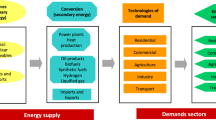Abstract
The behavior of DC load flow formulations when they are used in economic dispatch and nodal pricing models is discussed. It is demonstrated that non-negative prices in these models are sufficient to guarantee global optimality of any local optimum, even if the feasible region is not convex, and so a negative nodal price is an indicator of a possible loss in optimality. We also discuss the possible effect that negative prices might have on algorithms that assume this convexity.




Similar content being viewed by others
References
River M, Pérez-Arriaga IJ, Luengo G (1990) A model for computation of spot prices in interconnected power systems. In: 10th PSCC conf, Graz, Austria
Wood A, Wollenberg B (1996) Power generation, operation and control. Wiley, New York
Philpott A (1999) Experiments with load flow pricing models. In: CRNEC policy conference, Auckland, New Zealand
Stott B, Jardin J, Alsac O (2009) DC power flow revisited. IEEE Trans Power Syst 24:1290–1300
Escobar J, Jofre A (2010) Monopolistic competition in electricity networks with resistance losses. Econ Theory 44:101–121
Ilog (2002) CPLEX 8.1. Reference manual
Murtagh B, Saunders M (1983) MINOS 5.0 user’s guide. Systems optimization laboratory dept of operations research, Stanford University, tech rep (83-20)
Philpott A, Pritchard G (2004) Financial transmission rights in convex pool markets. Oper Res Lett 32:109–113
Bazaraa M, Sherali H, Shetty C (2006) Nonlinear programming, theory and algorithms. Wiley, New York
Chaturvedi K, Pandit M, Srivastava L (2008) Self-organizing hierarchical particle swarm, optimization for nonconvex economic dispatch. IEEE Trans Power Syst 23:1079–1087
Alvey T, Ma X, Sun D (1998) A security-constrained bid-clearing system for the New Zealand wholesale electricity market. IEEE Trans Power Syst 13:340–346
De la Torre S, Galiana F (2005) On the convexity of the system loss function. IEEE Trans Power Syst 20:2061–2069
Acknowledgements
We would like to acknowledge the financial support provided by Fondecyt Grant #1080668 and the Royal Society of New Zealand International Science and Technology Linkages Grant ISATB04-I09. We want to thank Mr Tony Downward, Mr. Ignacio Alarcón and Mr. Rigoberto Torres for fruitful discussions on this topic.
Author information
Authors and Affiliations
Corresponding author
Additional information
This work was funded by Fondecyt Grand No. 1080668 Chile’s government and the Royal Society of New Zealand International Science and Technology Linkages Grant ISATB04-I09.
Rights and permissions
About this article
Cite this article
Palma-Benhke, R., Philpott, A., Jofré, A. et al. Modelling network constrained economic dispatch problems. Optim Eng 14, 417–430 (2013). https://doi.org/10.1007/s11081-012-9203-5
Received:
Accepted:
Published:
Issue Date:
DOI: https://doi.org/10.1007/s11081-012-9203-5




